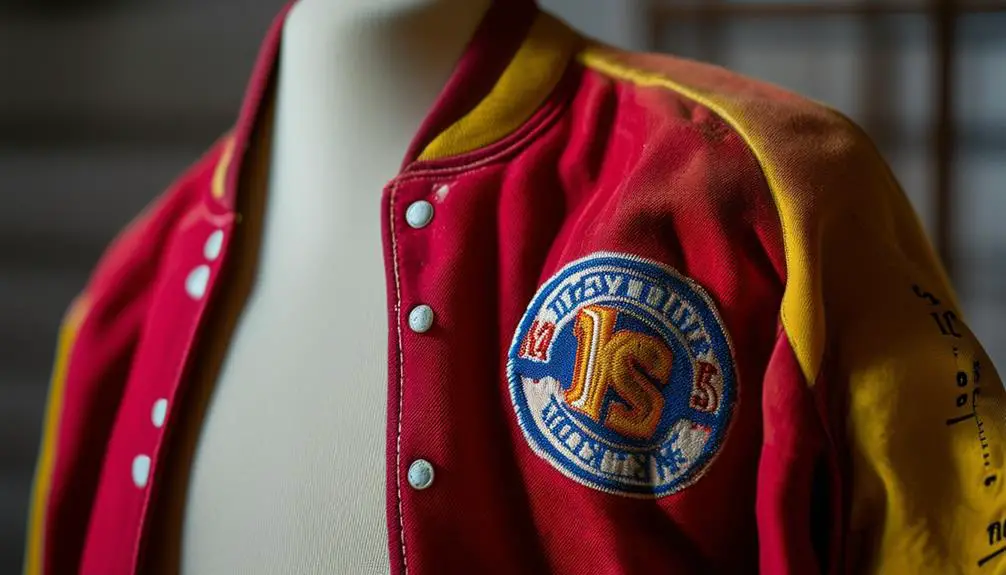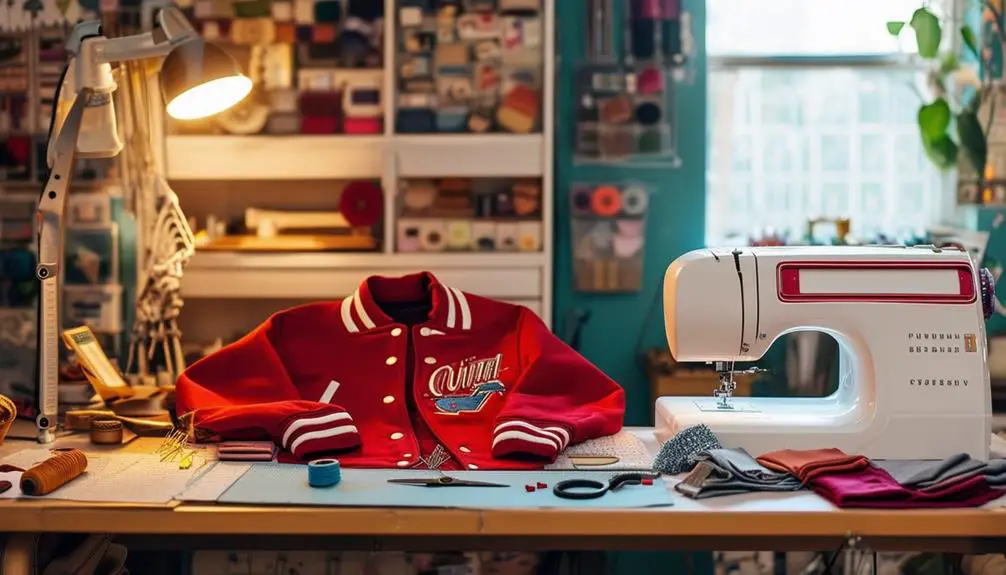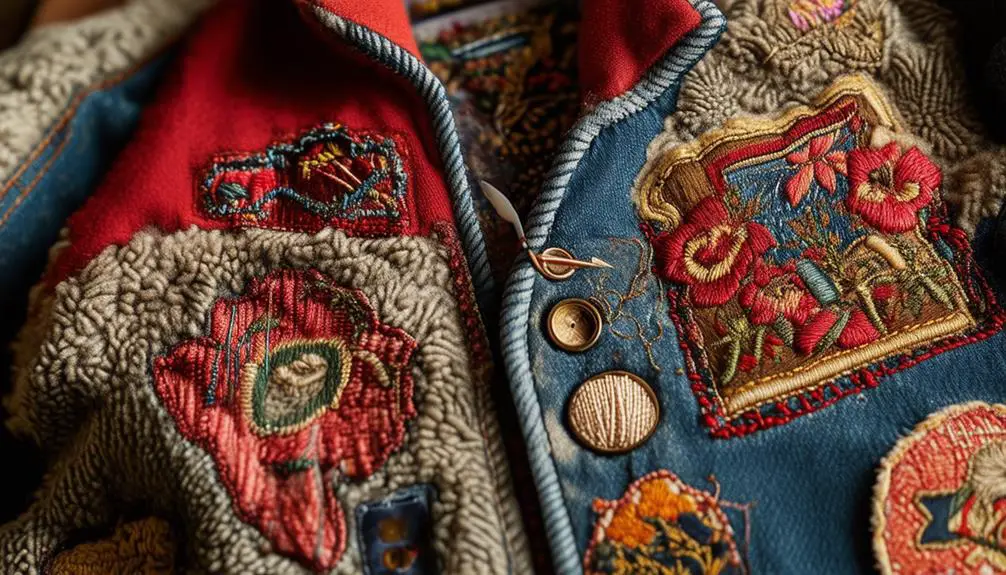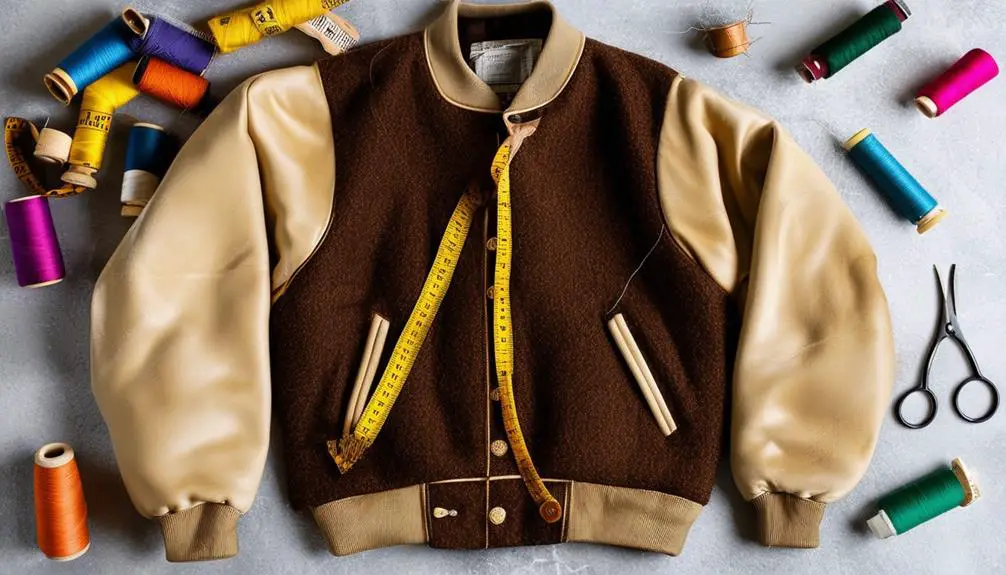To tailor a vintage varsity jacket, start by evaluating the fit. Move around to identify any restrictive areas. Measure the shoulders, chest, waist, and sleeve length, then compare these against your desired fit. You'll need tools like a measuring tape, sharp fabric scissors, and a sewing machine. If you're unsure, consulting a professional tailor is a smart move. Remember to maintain the jacket's unique patches and embroidery during alterations. A successful tailoring process not only enhances comfort but also preserves your jacket's character. Keep exploring to find tips on lining replacement and maintenance for longevity!
Assessing Your Jacket Fit

When you slip on your vintage varsity jacket, take a moment to really assess how it feels.
Stand tall, sit down, and raise your arms—this helps you identify any areas that feel restrictive or baggy. Is the fit snug around your shoulders, or does it hang loosely?
Measuring key areas like the shoulders, chest, waist, and sleeve length with a tape measure allows you to compare your current fit against your desired alterations.
Keep an eye out for signs of shrinkage, especially in the body and sleeves, as this can affect the overall fit.
Pay attention to the jacket's original construction details—like the lining and seams—because they determine how much alteration you can realistically make without compromising its integrity.
Tools Needed for Tailoring
Having the right tools is essential for achieving a polished look when tailoring your vintage varsity jacket. With the right equipment, you'll guarantee accurate measurements and clean alterations.
Understanding the unique characteristics of vintage clothing can also inform your tailoring choices, particularly when working with specific fabrics or construction techniques typical of certain eras, such as those seen in vintage clothing trends by era.
Here's a list of must-have tools to get you started:
- Measuring Tape: For precise fitting, this is your best friend. It'll help you take accurate measurements to create the perfect silhouette.
- Sharp Fabric Scissors: Invest in good scissors to guarantee clean cuts, which are critical for a professional finish.
- Tailor's Chalk: This allows you to mark alterations directly on the fabric, making it easy to see where adjustments need to be made.
- Sewing Machine: A reliable sewing machine is essential for making sturdy seams, especially on thicker materials like wool and leather.
Additionally, consider having pins or clips handy for holding fabric pieces together before sewing, and a seam ripper for removing stitches without damaging the fabric.
Tailoring tape or a fitting garment can also help achieve a more contoured fit. With these tools, you're well on your way to creating a tailored masterpiece!
Step-by-Step Alteration Process

Tailoring your vintage varsity jacket involves a careful and thoughtful process that enhances both fit and style. Start by evaluating the jacket's fabric. Since wool bodies are generally easier to alter than leather sleeves, plan your alterations accordingly.
If you're unsure about making adjustments yourself, consult a professional tailor experienced in leather and vintage garments. This way, you'll avoid any damage that could occur from improper alterations.
Before starting, clearly communicate your desired fit to the tailor. Whether you want to adjust the sleeve length or taper the body, being specific will help achieve the look you're going for.
Expect tailoring costs to range from $100 to $150, depending on the complexity of the adjustments needed, so budget accordingly.
Once your jacket is tailored, maintain its shape and longevity with regular care. Clean it properly and store it in a way that prevents damage.
Adding or Replacing Linings
A well-chosen lining can transform your vintage varsity jacket, enhancing both its comfort and visual appeal. When pondering adding or replacing linings, pay attention to the fabric. It should complement the original materials while guaranteeing durability and comfort.
Vintage clothing often uses more durable materials, so selecting the right fabric is vital for maintaining the jacket's integrity. If you're unsure, consulting a professional tailor experienced with vintage garments is essential to maintain your jacket's integrity. You may also want to look into identifying vintage clothing to verify your jacket's style aligns with classic trends.
Here are some factors to keep in mind when selecting your lining:
- Fabric Choice: Opt for materials like cotton or satin that enhance comfort.
- Condition Assessment: Check if the original lining is still intact, as replacing it may not be necessary if it's in good shape.
- Cost Evaluation: Expect to spend between $50 to $100 for lining replacement, depending on the complexity and materials.
- Fit and Warmth: A new lining can improve the overall fit and warmth, making your jacket more enjoyable to wear.
Don't forget about the vinyl sleeves! They can affect how the lining looks and feels, so make sure the new lining complements them.
With the right lining, your vintage varsity jacket can remain stylish and functional for years to come.
Preserving Patches and Embroidery

Preserving the unique patches and embroidery on your vintage varsity jacket is vital for maintaining its character and history. These elements tell a story, and you wouldn't want to lose that narrative during the tailoring process. Consult a professional tailor experienced in varsity jackets, as they understand how to handle these delicate features without causing damage.
Consider removing patches before alterations and reattaching them afterward. This method minimizes the risk of interference during tailoring adjustments. Clear communication with your tailor about which patches or embroidery you'd love to preserve can make all the difference.
Here's a quick reference table to keep in mind:
| Action | Importance | Outcome |
|---|---|---|
| Consult a professional | Expertise in handling vintage fabrics | Preserves integrity |
| Remove patches pre-alteration | Avoids damage during alterations | Maintains original look |
| Communicate clearly | Guarantees tailor understands your needs | Careful handling |
| Regular maintenance | Prolongs life of patches and embroidery | Keeps them vibrant |
Maintenance Tips for Longevity
To guarantee your vintage varsity jacket stands the test of time, regular maintenance is essential. By taking the right steps, you can preserve its charm and functionality, especially if it features leather sleeves. Here are some key tips to keep in mind:
- Clean with saddle soap: Regularly clean the vinyl sleeves to remove any sticky or greasy residues, which helps maintain their appearance and prolongs their lifespan.
- Store properly: Keep your jacket in a cool, dry place to prevent moth damage and moisture-related issues that could lead to deterioration.
- Use sturdy hangers: Avoid flimsy hangers; opt for padded or wide hangers to maintain the jacket's shape and prevent stretching of the fabric.
- Inspect regularly: Conduct periodic checks for loose patches or seams. Early identification of repair needs allows for timely professional alterations, extending the jacket's longevity.
Additionally, don't forget to use a leather conditioner on the leather sleeves. This keeps them supple and prevents cracking, ensuring your vintage varsity jacket remains in excellent condition for years to come.
Frequently Asked Questions
Can You Get a Varsity Jacket Altered?
Yes, you can definitely get a varsity jacket altered! Just remember, the fabric type matters. Wool's easier to work with than leather, so choose a skilled tailor to guarantee your jacket fits perfectly.
Are Varsity Jackets Supposed to Be Oversized?
Varsity jackets are traditionally oversized, allowing for comfort and layering. This classic style embodies youthful spirit and heritage. However, personal taste and modern trends might lead you to prefer a more tailored fit.
Can You Sew Patches on Varsity Jacket?
Yes, you can sew patches on your varsity jacket! Choose heavy-duty polyester thread for durability, and guarantee the fabric type matches. Consider using an embroidery machine for a polished finish, especially on intricate designs.
How to Stretch a Varsity Jacket?
To stretch your varsity jacket, wear it during light activities, soak it in lukewarm water, or enlist a professional tailor. Remember to add fabric conditioner for softness while preserving its shape and integrity.




Your point of view caught my eye and was very interesting. Thanks. I have a question for you.